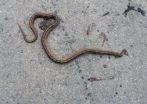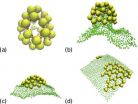(Press-News.org) Using a whopping nine-gigapixel image from the VISTA infrared survey telescope at ESO's Paranal Observatory, an international team of astronomers has created a catalogue of more than 84 million stars in the central parts of the Milky Way. This gigantic dataset contains more than ten times more stars than previous studies and is a major step forward for the understanding of our home galaxy. The image gives viewers an incredible, zoomable view of the central part of our galaxy. It is so large that, if printed with the resolution of a typical book, it would be 9 metres long and 7 metres tall.
"By observing in detail the myriads of stars surrounding the centre of the Milky Way we can learn a lot more about the formation and evolution of not only our galaxy, but also spiral galaxies in general," explains Roberto Saito (Pontificia Universidad Catolica de Chile, Universidad de Valparaiso and The Milky Way Millennium Nucleus, Chile), lead author of the study.
Most spiral galaxies, including our home galaxy the Milky Way, have a large concentration of ancient stars surrounding the centre that astronomers call the bulge. Understanding the formation and evolution of the Milky Way's bulge is vital for understanding the galaxy is a whole. However, obtaining detailed observations of this region is not an easy task.
"Observations of the bulge of the Milky Way are very hard because it is obscured by dust," says Dante Minniti (Pontificia Universidad Catolica de Chile, Chile), co-author of the study. "To peer into the heart of the galaxy, we need to observe in infrared light, which is less affected by the dust."
The large mirror, wide field of view and very sensitive infrared detectors of ESO's 4.1-metre Visible and Infrared Survey Telescope for Astronomy (VISTA) make it by far the best tool for this job. The team of astronomers is using data from the VISTA Variables in the Via Lactea programme (VVV) [1], one of six public surveys carried out with VISTA. The data have been used to create a monumental 108 200 by 81 500 pixel colour image containing nearly nine billion pixels. This is one of the biggest astronomical images ever produced. The team has now used these data to compile the largest catalogue of the central concentration of stars in the Milky Way ever created [2].
To help analyse this huge catalogue the brightness of each star is plotted against its colour for about 84 million stars to create a colour-magnitude diagram. This plot contains more than ten times more stars than any previous study and it is the first time that this has been done for the entire bulge. Colour-magnitude diagrams are very valuable tools that are often used by astronomers to study the different physical properties of stars such as their temperatures, masses and ages [3].
"Each star occupies a particular spot in this diagram at any moment during its lifetime. Where it falls depends on how bright it is and how hot it is. Since the new data gives us a snapshot of all the stars in one go, we can now make a census of all the stars in this part of the Milky Way," explains Dante Minniti.
The new colour-magnitude diagram of the bulge contains a treasure trove of information about the structure and content of the Milky Way. One interesting result revealed in the new data is the large number of faint red dwarf stars. These are prime candidates around which to search for small exoplanets using the transit method [4].
"One of the other great things about the VVV survey is that it's one of the ESO VISTA public surveys. This means that we're making all the data publicly available through the ESO data archive, so we expect many other exciting results to come out of this great resource," concludes Roberto Saito.
INFORMATION:
Notes
[1] The VISTA Variables in the Via Lactea (VVV) survey is an ESO public survey dedicated to scanning the southern plane and bulge of the Milky Way through five near-infrared filters. It started in 2010 and was granted a total of 1929 hours of observing time over a five-year period. Via Lactea is the Latin name for the Milky Way.
[2] The image used in this work covers about 315 square degrees of the sky (a bit less than 1% of the entire sky) and observations were carried out using three different infrared filters. The catalogue lists the positions of the stars along with their measured brightnesses through the different filters. It contains about 173 million objects, of which about 84 million have been confirmed as stars. The other objects were either too faint or blended with their neighbours or affected by other artefacts, so that accurate measurements were not possible. Others were extended objects such as distant galaxies.
The image used here required a huge amount of data processing, which was performed by Ignacio Toledo at the ALMA OSF. It corresponds to a pixel scale of 0.6 arcseconds per pixel, down-sampled from the original pixel scale 0.34 arcseconds per pixel.
[3] A colour-magnitude diagram is a graph that plots the apparent brightnesses of a set of objects against their colours. The colour is measured by comparing how bright objects look through different filters. It is similar to a Hertzsprung-Russell (HR) diagram but the latter plots luminosity (or absolute magnitude) rather than just apparent brightness and a knowledge of the distances of the stars plotted is also needed.
[4] The transit method for finding planets searches for the small drop in brightness of a star that occurs when a planet passes in front of it and blocks some of its light. The small size of the red dwarf stars, typically with spectral types K and M, gives a greater relative drop in brightness when low-mass planets pass in front of them, making it easier to search for planets around them.
More information
This research was presented in a paper "Milky Way Demographics with the VVV Survey I. The 84 Million Star Colour-Magnitude Diagram of the Galactic Bulge" by R. K. Saito et al., which was published in the journal Astronomy & Astrophysics (A&A, 544, A147).
The team is composed of R. K. Saito (Pontificia Universidad Catolica de Chile, Santiago, Chile; Universidad de Valparaiso, Chile; The Milky Way Millennium Nucleus, Chile), D. Minniti (Pontificia Universidad Catolica de Chile; Vatican Observatory), B. Dias (Universidade de Sao Paulo, Brazil), M. Hempel (Pontificia Universidad Catolica de Chile), M. Rejkuba (ESO, Garching, Germany), J. Alonso-Garcia (Pontificia Universidad Catolica de Chile), B. Barbuy (Universidade de Sao Paulo), M. Catelan (Pontificia Universidad Catolica de Chile), J. P. Emerson (Queen Mary University of London, United Kingdom), O. A. Gonzalez (ESO, Garching, Germany), P. W. Lucas (University of Hertfordshire, Hatfield, United Kingdom) and M. Zoccali (Pontificia Universidad Catolica de Chile).
The year 2012 marks the 50th anniversary of the founding of the European Southern Observatory (ESO). ESO is the foremost intergovernmental astronomy organisation in Europe and the world's most productive ground-based astronomical observatory by far. It is supported by 15 countries: Austria, Belgium, Brazil, the Czech Republic, Denmark, France, Finland, Germany, Italy, the Netherlands, Portugal, Spain, Sweden, Switzerland and the United Kingdom. ESO carries out an ambitious programme focused on the design, construction and operation of powerful ground-based observing facilities enabling astronomers to make important scientific discoveries. ESO also plays a leading role in promoting and organising cooperation in astronomical research. ESO operates three unique world-class observing sites in Chile: La Silla, Paranal and Chajnantor. At Paranal, ESO operates the Very Large Telescope, the world's most advanced visible-light astronomical observatory and two survey telescopes. VISTA works in the infrared and is the world's largest survey telescope and the VLT Survey Telescope is the largest telescope designed to exclusively survey the skies in visible light. ESO is the European partner of a revolutionary astronomical telescope ALMA, the largest astronomical project in existence. ESO is currently planning a 40-metre-class European Extremely Large optical/near-infrared Telescope, the E-ELT, which will become "the world's biggest eye on the sky".
Links
[Research paper (A&A, 544, A147)][1]
[Photos of the VISTA telescope][2]
[Images taken with the VISTA telescope][3]
[1]: http://www.aanda.org/10.1051/0004-6361/201219448
[2]: http://www.eso.org/public/images/archive/search/?adv=&subject_name=Visible and Infrared Survey Telescope for Astronomy
[3]: http://www.eso.org/public/images/archive/search/?adv=&facility=30
Contacts
Roberto Saito
Pontificia Universidad Católica de Chile
Santiago, Chile
Tel: +56 2 354 5767
Email: rsaito@astro.puc.cl
Dante Minniti
Pontificia Universidad Católica de Chile
Santiago, Chile
Tel: +56 2 463 3267
Email: dante@astro.puc.cl
Richard Hook
ESO, La Silla, Paranal, E-ELT and Survey Telescopes Public Information Officer
Garching bei München, Germany
Tel: +49 89 3200 6655
Cell: +49 151 1537 3591
Email: rhook@eso.org
84 million stars and counting
VISTA creates largest ever catalog of center of our galaxy
2012-10-24
ELSE PRESS RELEASES FROM THIS DATE:
A 84-million star color-magnitude diagram of the Milky Way bulge
2012-10-24
Astronomy & Astrophysics published the first analysis of a catalog of 84 million individual stars in the Milky Way bulge as a part of the VVV ESO public survey. This gigantic data set allows building the largest, deepest, and most accurate color-magnitude diagram ever produced, containing more than ten times more stars than any previous study.
The bulge of the Milky Way is a large central concentration of ancient stars that is predominantly observed from the southern hemisphere. Understanding the formation and evolution of the bulge is fundamental for deciphering the ...
Herbal and dietary supplements can adversely affect prescribed drugs says extensive review
2012-10-24
A number of herbs and dietary supplements (HDS) can cause potentially harmful drug interactions, particularly among people receiving medication for problems with their central nervous or cardiovascular systems.
Those are the key findings of an extensive research review published in the November issue of IJCP, the International Journal of Clinical Practice.
Researchers examined 54 review articles and 31 original studies. They found that the greatest problems were caused by interactions between prescribed drugs and HDS that included ingredients such as St John's Wort, ...
Mouse model exposes a new type of T cell to target melanoma
2012-10-24
October 24, 2012, New York, NY – Cancers arise in the body all the time. Most are nipped in the bud by the immune response, not least by its T cells, which detect telltale molecular markers—or antigens—on cancer cells and destroy them before they grow into tumors. Cancer cells, for their part, evolve constantly to evade such assassination. Those that succeed become full-blown malignancies. Yet, given the right sort of help, the immune system can destroy even these entrenched tumors.
In the October 22nd issue of the Journal of Experimental Medicine, researchers led by ...
A new take on the Midas touch -- changing the color of gold
2012-10-24
Red gold, green gold – a ground-breaking initiative has found a way of changing the colour of the world's most iconic precious metal.
A University of Southampton team have discovered that by embossing tiny raised or indented patterns onto the metal's surface they can change the way it absorbs and reflects light – ensuring our eyes don't see it as 'golden' in colour at all.
The finding results from a major initiative funded by the Engineering and Physical Sciences Research Council (EPSRC) targeting the development of a new generation of nanotechnology-enabled materials. ...
The majority of roadkill amongst vertebrates in Catalonia are in protected areas
2012-10-24
Amphibians are the vertebrate group that is more likely to become roadkill in Catalonia, even more so than reptiles, mammals and birds. This is the case according to an international team of scientists who have concluded that highly protected areas are home to more cases of animal death on the roads.
Our network of roads is considered one of the main threats to fauna survival. Researchers at the universities of Barcelona (UB), Porto (Portugal) and Uppsala (Sweden) have studied the number of vertebrate deaths on 820 kilometres of road in North Eastern area of Spain and ...
New insights into membrane-assisted self-assembly
2012-10-24
"In our current paper we present new computational results that explore how membranes may influence crucial biological processes", explains Richard Matthews, Lise-Meitner-Fellow at the University of Vienna and first author of the study. The focus of the investigation is the self-assembly of microscopic particles, the formation of structures or patterns without human intervention. More specifically, the effect of the interactions between membranes and proteins, which can influence the formation of ordered structures in cells, is considered.
Self-assembly has become a hot ...
Study: Flame retardant 'Firemaster 550' is an endocrine disruptor
2012-10-24
The flame-retardant mixture known as "Firemaster 550" is an endocrine disruptor that causes extreme weight gain, early onset of puberty and cardiovascular health effects in lab animals, according to a new study spearheaded by researchers from North Carolina State University and Duke University.
Firemaster 550 is made up of four principal component chemicals and is used in polyurethane foam in a wide variety of products, ranging from mattresses to infant nursing pillows. The flame-retardant mixture was developed by Chemtura Corp., and was first identified by the research ...
Voice prostheses can help patients regain their lost voice
2012-10-24
Help is on the way for people who suffer from vocal cord dysfunction. Researchers are developing methods that will contribute to manufacturing voice prostheses with improved affective features. For example, for little girls who have lost their voices, the improved artificial voice devices can produce age-appropriate voices, instead of the usual voice of an adult male. These advances in artificial voice production have been made possible by results achieved in a research project led by Professor Samuli Siltanen, results that are good news indeed for the approximately 30,000 ...
Unearthing a hidden dietary behavior
2012-10-24
Though it was identified as a disorder as early as the 14th century, pica, or the eating of non-food items, has for years believed to be all but non-existent in a few corners of the globe – a 2006 study that reviewed research on pica found just four regions – the South of South America, Japan, Korea and Madagascar –where the behavior had never been observed.
A new Harvard study, however, is showing that pica – and particularly geophagy, or the eating of soil or clay, is far more prevalent in Madagascar, and may be more prevalent worldwide, than researchers previously ...
Hypnosis helps hot flashes
2012-10-24
CLEVELAND, Ohio (October 24, 2012)—Hypnosis can help cut hot flashes by as much as 74%, shows a study supported by the National Center for Complementary and Alternative Medicine. This is the first controlled, randomized study of the technique to manage hot flashes, which affect as much as 80% of women who go through menopause. The study was published online this month in Menopause, the journal of the North American Menopause Society.
Controlled, randomized studies may pit an active drug against an inactive placebo pill. But it's hard to find a placebo for mind-body techniques. ...
LAST 30 PRESS RELEASES:
Sea reptile’s tooth shows that mosasaurs could live in freshwater
Pure bred: New stem cell medium only has canine components
Largest study of its kind highlights benefits – and risks – of plant-based diets in children
Synergistic effects of single-crystal HfB2 nanorods: Simultaneous enhancement of mechanical properties and ablation resistance
Mysterious X-ray variability of the strongly magnetized neutron star NGC 7793 P13
The key to increasing patients’ advance care medical planning may be automatic patient outreach
Palaeontology: Ancient tooth suggests ocean predator could hunt in rivers
Polar bears may be adapting to survive warmer climates, says study
Canadian wildfire smoke worsened pediatric asthma in US Northeast: UVM study
New UBCO research challenges traditional teen suicide prevention models
Diversity language in US medical research agency grants declined 25% since 2024
Concern over growing use of AI chatbots to stave off loneliness
Biomedical authors often call a reference “recent” — even when it is decades old, analysis shows
The Lancet: New single dose oral treatment for gonorrhoea effectively combats drug-resistant infections, trial finds
Proton therapy shows survival benefit in Phase III trial for patients with head and neck cancers
Blood test reveals prognosis after cardiac arrest
UBCO study finds microdosing can temporarily improve mood, creativity
An ECOG-ACRIN imaging study solves a long-standing gap in metastatic breast cancer research and care: accurately measuring treatment response in patients with bone metastases
Cleveland Clinic presents final results of phase 1 clinical trial of preventive breast cancer vaccine study
Nationally renowned anesthesiology physician-scientist and clinical operations leader David Mintz, MD, PhD, named Chair of the Department of Anesthesiology at the UM School of Medicine
Clean water access improves child health in Mozambique, study shows
Study implicates enzyme in neurodegenerative conditions
Tufts professor named Fellow of the National Academy of Inventors
Tiny new device could enable giant future quantum computers
Tracing a path through photosynthesis to food security
First patient in Arizona treated with new immune-cell therapy at HonorHealth Research Institute
Studies investigate how AI can aid clinicians in analyzing medical images
Researchers pitch strategies to identify potential fraudulent participants in online qualitative research
Sweeping study shows similar genetic factors underlie multiple psychiatric disorders
How extreme weather events affect agricultural trade between US states
[Press-News.org] 84 million stars and countingVISTA creates largest ever catalog of center of our galaxy


